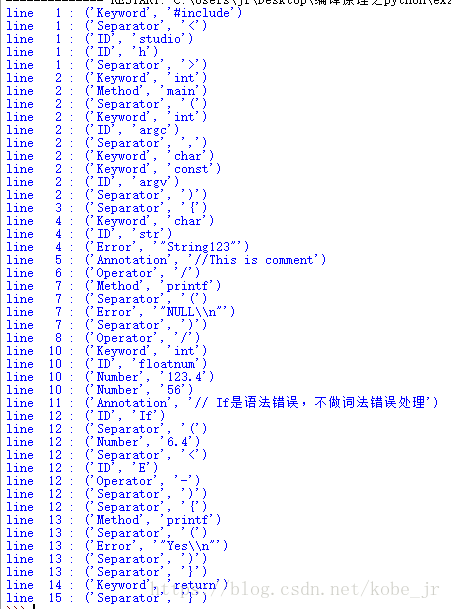python基础:
1、list的使用,即列表。定义:list(列表名) = [];如下还有对他的遍历,这里的word算是定义了一个变量去存储res[i]的值:
# -*- coding: cp936 -*-
if __name__=="__main__":
res = []
res = ["hello", "you", "are", "good"]
i = 0
#对列表的遍历
for word in res:
print("第", i ,"位置的元素", word)
i = i + 1

2、缩进问题: 一般默认为4个空格的缩进,可以使用tab键或者空格,但是注意如果使用混乱,可能出现unexcepted indent之类的错误。
3、注释:使用#号,如果是多行注释则是''' XXX '''(头尾三个单引号,注意中英文的区别)。
4、函数定义:def 函数名; 或者利用函数对象的__name__属性: if __name__=="__main__"。
5、正则表达式的使用:
import re : 使用python自己的正则表达式模块,其中有对应的方法。(下面编写了不少正则表达式,可以参考)。这里举常见的一个例子:根据空格分隔字符串:
# -*- coding: cp936 -*-
import re
if __name__=="__main__":
temp = 'aaa bbb ccc ddd eee'
res = re.split('\s+', temp)
print(res)6、读写文件(使用的是with/ 还可以使用open- read- close):
# -*- coding: cp936 -*-
if __name__=="__main__":
filename = 'D:\demo.txt'
filename2 = 'D:\demo1.txt'
with open(filename, "r") as fin:
res = [line.strip() for line in fin]
print(res)
#for line in fin:
#print(line)
with open(filename2, "a") as fo:
#这里写在txt文件式一行,因为它是按行读的。
for line in res:
if line:
fo.write(line)
else:
continue词法分析:
是编译原理中第一步需要做的事,将给定的程序或者其他读取,根据词的类别不同,进行分类。即可以理解将一段程序分成一个个的词。
先读取test.c的内容,存进一个列表中, 然后通过和数个正则表达式进行match匹配,从而进行分类。这里分类还是存在一些小的问题,欢迎提出更优的解决方案。谢谢!
待读的代码:
#include <studio.h>
int main(int argc, char const *argv[])
{
char *str = "String123";
//This is comment
/**
printf("NULL\n");
*/
int floatnum = 123.4.56;
// If是语法错误,不做词法错误处理
If(6.4 <= 3E-1){
printf("Yes\n");}
return 0;
}参考代码:
#!/usr/bin/python
# -*- coding: cp936 -*-
#ex2.py
import re
class Token(object):
#初始化
def __init__(this):
#存储分词的列表
this.results = []
#行号
this.lineno = 1
#关键字
this.keywords = ['auto', 'struct', 'if', 'else', 'for', 'do', 'while', 'const',
'int', 'double', 'float', 'long', 'char', 'short', 'unsigned',
'switch', 'break', 'defalut', 'continue', 'return', 'void', 'static',
'auto', 'enum', 'register', 'typeof', 'volatile', 'union', 'extern']
'''
regex中:*表示从0-, +表示1-, ?表示0-1。对应的需要转义
{ 表示限定符表达式开始的地方 \{
() 标记一个子表达式的开始和结束位置。子表达式可以获取共以后使用:\( \)
r表示原生字符串。
'''
Keyword = r'(?P<Keyword>(auto){1}|(double){1}|(int){1}|(if){1}|' \
r'(#include){1}|(return){1}|(char){1}|(stdio\.h){1}|(const){1})'
#运算符
Operator = r'(?P<Operator>\+\+|\+=|\+|--|-=|-|\*=|/=|/|%=|%)'
#分隔符/界符
Separator = r'(?P<Separator>[,:\{}:)(<>])'
#数字: 例如:1 1.9
Number = r'(?P<Number>\d+[.]?\d+)'
#变量名 不能使用关键字命名
ID = r'(?P<ID>[a-zA-Z_][a-zA-Z_0-9]*)'
#方法名 {1} 重复n次
Method = r'(?P<Method>(main){1}|(printf){1})'
#错误 \S 匹配任意不是空白符的字符
#Error = r'(?P<Error>.*\S+)'
Error = r'\"(?P<Error>.*)\"'
#注释 ^匹配行的开始 .匹配换行符以外的任意字符 \r回车符 \n换行符
Annotation = r'(?P<Annotation>/\*(.|[\r\n])*/|//[^\n]*)'
#进行组装,将上述正则表达式以逻辑的方式进行拼接, 按照一定的逻辑顺序
# compile函数用于编译正则表达式,生成一个正则表达式对象
this.patterns = re.compile('|'.join([Annotation, Keyword, Method, ID, Number, Separator, Operator, Error]))
#读文件
def read_file(this, filename):
with open(filename, "r") as f_input:
return [line.strip() for line in f_input]
#结果写入文件
def write_file(this, lines, filename = 'D:/results.txt'):
with open(filename, "a") as f_output:
for line in lines:
if line:
f_output.write(line)
else:
continue
def get_token(this, line):
#finditer : 在字符串中找到正则表达式所匹配的所有字串, 并把他们作为一个迭代器返回
for match in re.finditer(this.patterns, line):
#group():匹配的整个表达式的字符 # yield 关键字:类似return ,返回的是一个生成器,generator
yield (match.lastgroup, match.group())
def run(this, line, flag=True):
for token in this.get_token(line):
if flag:
print ("line %3d :" % this.lineno, token)
'''
else:
yield "line %3d :" % this.lineno + str(token) + "\n"
'''
def printrun(this, line, flag = True):
for token in this.get_token(line):
if flag:
print ("lines x: ", token)
if __name__=='__main__':
token = Token()
filepath = "D:/Test.c"
lines = token.read_file(filepath)
for line in lines:
token.run(line, True)
#写入指定文件中
#token.write_file(token.run(line, False), "D:/results.txt")
token.lineno += 1
以上就是这篇的全部内容,欢迎提出您的意见。谢谢!





















 325
325

 被折叠的 条评论
为什么被折叠?
被折叠的 条评论
为什么被折叠?








